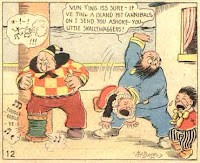 |
| Max and Moritz |
 |
| Katzenjammer Kids |
Comic strips were featured in newspapers as a way to help increase sales. Not only did they do just that - starting with The Yellow Kid - they also became a key factor in the newspaper war between newspaper giants Joseph Pulitzer and William Randolph Hearst. Comic strips have since become a standard feature in most newspapers.
Originally, comic strips were black and white from Monday-Saturday papers, and the coloured comics were featured in Sunday papers. That since has changed, as with many of the originally comic formats. Comics have moved from single panel to multi-panel; have developed their own visual symbolism (such as speech bubbles or tiny stars to show pain); and consistently feature the same characters within each new strip in a series. Many of these developments occurred early in comic strip history soon after they were developed and popularized.
 What's fascinating about the early popularity of comic strips was that they weren't all about humour. Many had moralistic undertones or were adventure-themed. In fact, many popular comic book characters, such as Batman and Spiderman, were originally simply in comic strips. People didn't read comic strips just to get a laugh. Moralistic or political undertones continued to be featured in comic strips, sometimes combined with humour. Doonesbury is known for its left-leaning political slant and commentary on politics. Charles Shulz's Peanuts has a certain mature philosophical undertone despite only featuring children.
What's fascinating about the early popularity of comic strips was that they weren't all about humour. Many had moralistic undertones or were adventure-themed. In fact, many popular comic book characters, such as Batman and Spiderman, were originally simply in comic strips. People didn't read comic strips just to get a laugh. Moralistic or political undertones continued to be featured in comic strips, sometimes combined with humour. Doonesbury is known for its left-leaning political slant and commentary on politics. Charles Shulz's Peanuts has a certain mature philosophical undertone despite only featuring children.Comic strips were also only featured in one particular paper (hence the Newspaper War), but now comic strips can be in multiple papers in multiple places, thanks to syndication. This has helped spread the popularity of certain comics like Peanuts, Doonesbury, and Garfield. In fact, many comics have spawned their own merchandise, T.V. shows, and movies, and have become icons within North American culture.
 |
| Classic Peanuts |